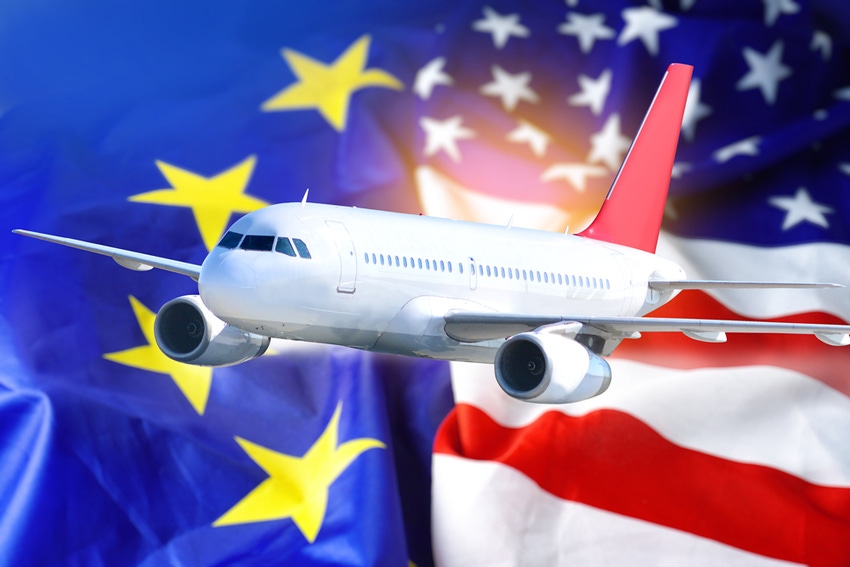We lay out the current rules for international travel and speak with key channel players about their flight plans.

There have been steps recently toward reopening international travel between the US and Europe. While this is good news, the situation does vary by country and can still seem a bit confusing to travellers.
Last month it was announced that fully vaccinated people from the US and EU could travel to the UK without needing to quarantine. Indeed, US carrier JetBlue was due to start flying between London and New York later this week.
This lifting of restrictions also stretches across Europe. Several countries, including Switzerland, France, Spain, and Germany, now allow travel for non-essential purposes from the US.
Despite this, the US State Department has this week advised Americans to avoid all travel to France over rising coronavirus cases in the country. This follows similar recommendations for Spain, Portugal and Cyprus.
And crucially, this lifting of restrictions is still somewhat of a one-way street as America’s borders remain closed to most European travellers. Virtually all residents of Europe’s Schengen Area – the passport-free zone that includes 26 countries plus other entities – and those living in Britain and Ireland are still barred from travelling to the US.
This obviously will continue to impact events, such as the IT conferences that are a staple of the channel. Despite this, there is growing optimism about a return to face-to-face meetings and events.
Channel Futures spoke to vendors, distributors and partners about what the gradual easing of restrictions means for their businesses. Will they make any travel plans, and are they eyeing a return to physical meetings?
‘We’re Optimistically Cautious’

Exclusive Networks’ Andy Travers
“The channel has always been – and will always be – about people and relationships.” That’s according to Andy Travers, EVP of sales and marketing, at distributor Exclusive Networks.
“During the pandemic, we’ve all had to adapt to a new way of working, fostering and maintaining these human interactions digitally. However, there’s no amount of collaboration technology that can replace an in-person, human-to-human connection.”
Travers says that as we move toward a new normal, there is a growing appetite for physical meetings, events and industry gatherings.
“We’ve already had a number of meetings as restrictions ease — with our vendors, our channel partners and our regional teams. [This allows] us to reconnect at a much more human level. However, as a global organisation, the challenge we face is adhering to the many government travel restrictions and ensuring we follow all local COVID-19 protocols. These will dictate whether it’s a physical, virtual or even hybrid environment.
“We continue to be vigilant and remain optimistically cautious; however, it’s great to start seeing people face to face again and not just on screen.”
‘An Objective, Data-Driven Approach’
Dayne Turbitt is UK SVP and GM at Dell Technologies. He says the safety, security and …
… well-being of team members, customers and partners are priorities.

Dell’s Dayne Turbitt
“It’s vital to remind ourselves that the pandemic is not over … COVID-19 hotspots and possible new variants will continue to create travel uncertainty for some time. We all need to be responsive and responsible — especially as the world starts to reopen,” he says.
Turbitt says recognizing that travel is sometimes important, Dell is turning to technology. The vendor is using “an objective, data-driven approach to make informed decisions regarding travel and in-person meetings and events. We use our COVID-19 Risk Reference matrix, a real-time dashboard developed by internal data scientists in partnership with medical professionals. This matrix assesses publicly available health data related to infections, recoveries, percentage of people vaccinated in an area and the trend inclines or declines of each. The tool automatically updates 188 countries based on the available data.”
The exec says Dell maps the health risk of each country where it has facilities and offices. This enables it to create a traffic light system for travel, with countries categorised as either red or green.
“Our team members are approved for business-critical domestic travel and gathering offsite if a location is green on the COVID-19 Risk Reference matrix. Onsite meetings are only permitted if the site has reopened. And naturally, we expect all Dell Technologies staff to adhere to local COVID-19 protocols. Gatherings in red locations require executive-level approval and are subject to a thorough risk assessment.
“Of course, I’m really looking forward to seeing team members, customers and partners in person again. But the data and science tell us that a cautious approach is the right one for now.”
‘Other Options at our Fingertips’
Rebecca Monk is HR director at one of the UK’s biggest channel partners, Softcat. She believes that emerging from the pandemic, international travel and travel in general will restart gradually.

Softcat’s Rebecca Monk
“But not, I imagine, to the level it was pre-pandemic,” she said.
“Technology and behaviours have moved forward at such a rate that we now have other options at our fingertips to use and can operate with a mix of in-person and virtual meetings.”
Monk says when making the decision of which route to follow, Softcat “will balance time, cost, value and the impact on the environment.”
This is a relevant point. In the early days of the pandemic, channel analyst firm Canalys noted firms can now revaluate how much of its travel is essential. At the same time, they can differentiate how much is an overhang from outdated notions of business.
“Travel will still be a necessity for many industries, but coronavirus presents an opportunity to … shift cultural frameworks for the future,” it said. “Companies cancelling or postponing events will likely realise that virtual interaction is more sustainable, cheaper and effective way to communicate.”
That said, Monk noted that “if travelling means building key relationships or fuelling existing ones and there is clear value in face-to-face engagements, then we will of course do so.”
‘Virtual Events Have Proven Their Value’
As an international business, travel restrictions significantly impacted distributor Westcon-Comstor.

Westcon-Comstor’s Paul Cunningham
“We were forced to adapt,” said CMO Paul Cunningham. “This has challenged our thinking about work, collaboration, technology, sales and marketing for the long term.”
Cunningham says pre-pandemic, marketing events accounted for around 60% of the firm’s collaborative spending with various partners.
“As with remote working, we pivoted quickly to a custom-built virtual events platform which we branded VENU. As well as sustaining our momentum as a sales and marketing operation, it taught us invaluable lessons about making virtual events that work, pandemic or no pandemic.
“Whatever comes next, virtual events have proven their value … [they] will increasingly be combined with physical and hybrid elements to create blended experiences. For many years, the webinar was seen as the poor relation of the live event. [It] attracted little creativity or platform-focused content and was seen as a cheap, fallback option. But the past 18 months have caused this to change forever.”
Cunningham has heard from many partners that think …
… most large-scale live events and conferences in Europe are unlikely to return until 2022. “Even when they do, there is likely to be a more cautious and selective approach to attendance for both economic and welfare reasons,” he said.
This, in turn, will require organisers and sponsors to ensure an equivalent digital and virtual experience to the physical.
“In earlier times, being remote would have been seen as a disadvantage and a hindrance. As the writer Gabriel Garcia Marquez wrote, ‘Humanity, like armies in the field, advances at the speed of the slowest.’ But that just won’t cut it in the next era. Parity of experience for our people and our partners, wherever they are and whatever they are doing, will be paramount,” said Cunningham.
‘Mixed Mode Approaches to Enablement’
The relaxation of travel points to the return of business travel, “probably toward the end of 2021 and during 2022.” That’s from David Wright, VP, marketing, Europe at Tech Data. He believes this will be “in a phased manner and of course dependent on local restrictions.”

Tech Data’s David Wright
However, Wright says there are no plans for attending international in-person events again, currently. But this is down to “few, if any, in-person events being held at the moment.”
He said the longer lead time needed for large-scale event planning may see international events making a stronger return in 2022. But again, this is “as long as the pandemic situation allows.”
“The mid-long term model for work in general is likely to be hybrid … this is probably the case for events too. Depending on the nature of the event, some may remain virtual. Others – for example those that emphasise high quality personal interactions – will probably return in a physical form.” Albeit, he says, “offering some virtual access for remote attendees.”
“We also expect to run – and be part of – mixed mode approaches to enablement, and collaborative programs in particular. For example, these would be structured around kickoff and capstone physical events with the intervening interactions being run on a virtual basis.”
Want to contact the author directly about this story? Have ideas for a follow-up article? Email Christine Horton or connect with her on LinkedIn. |
About the Author(s)
You May Also Like


